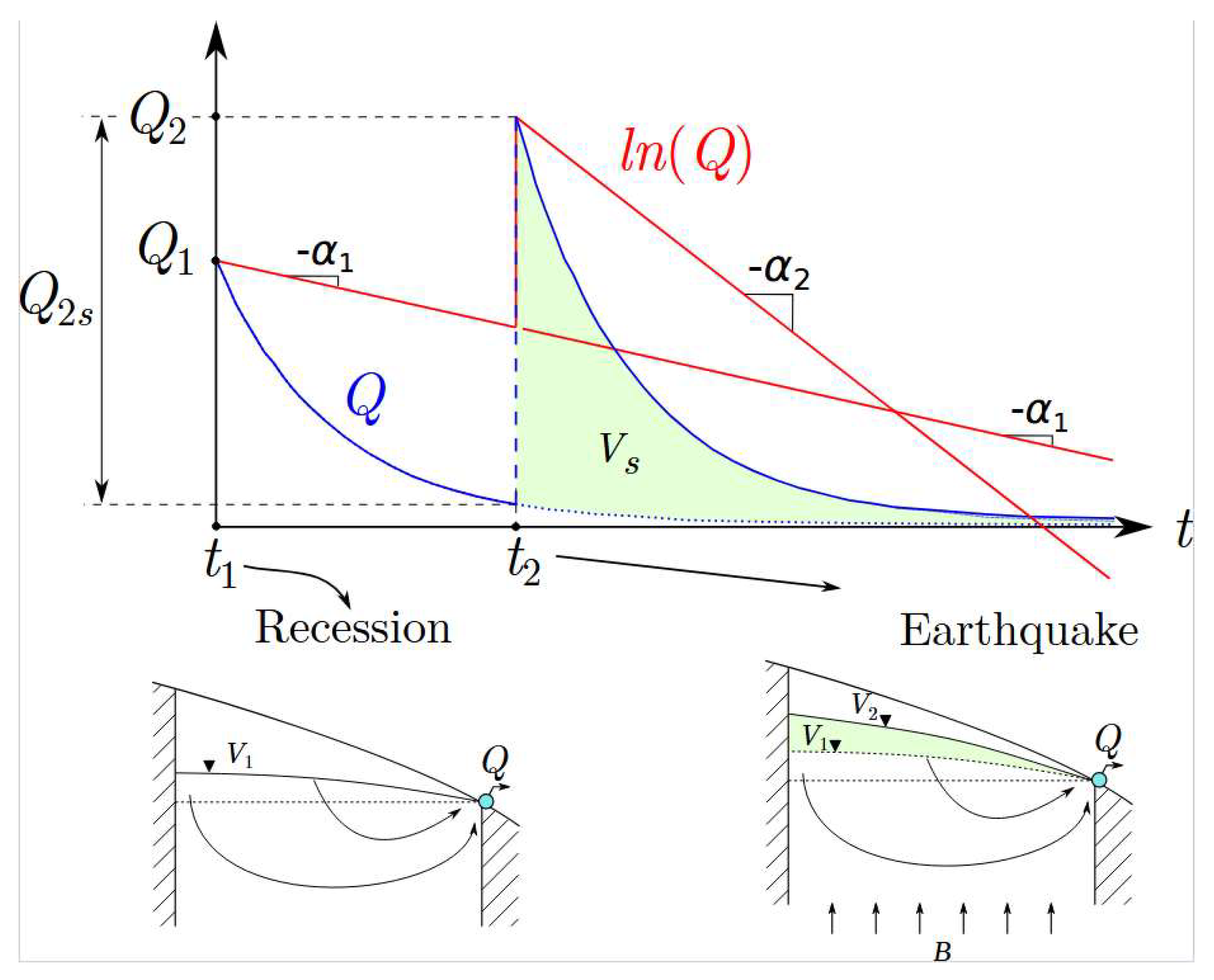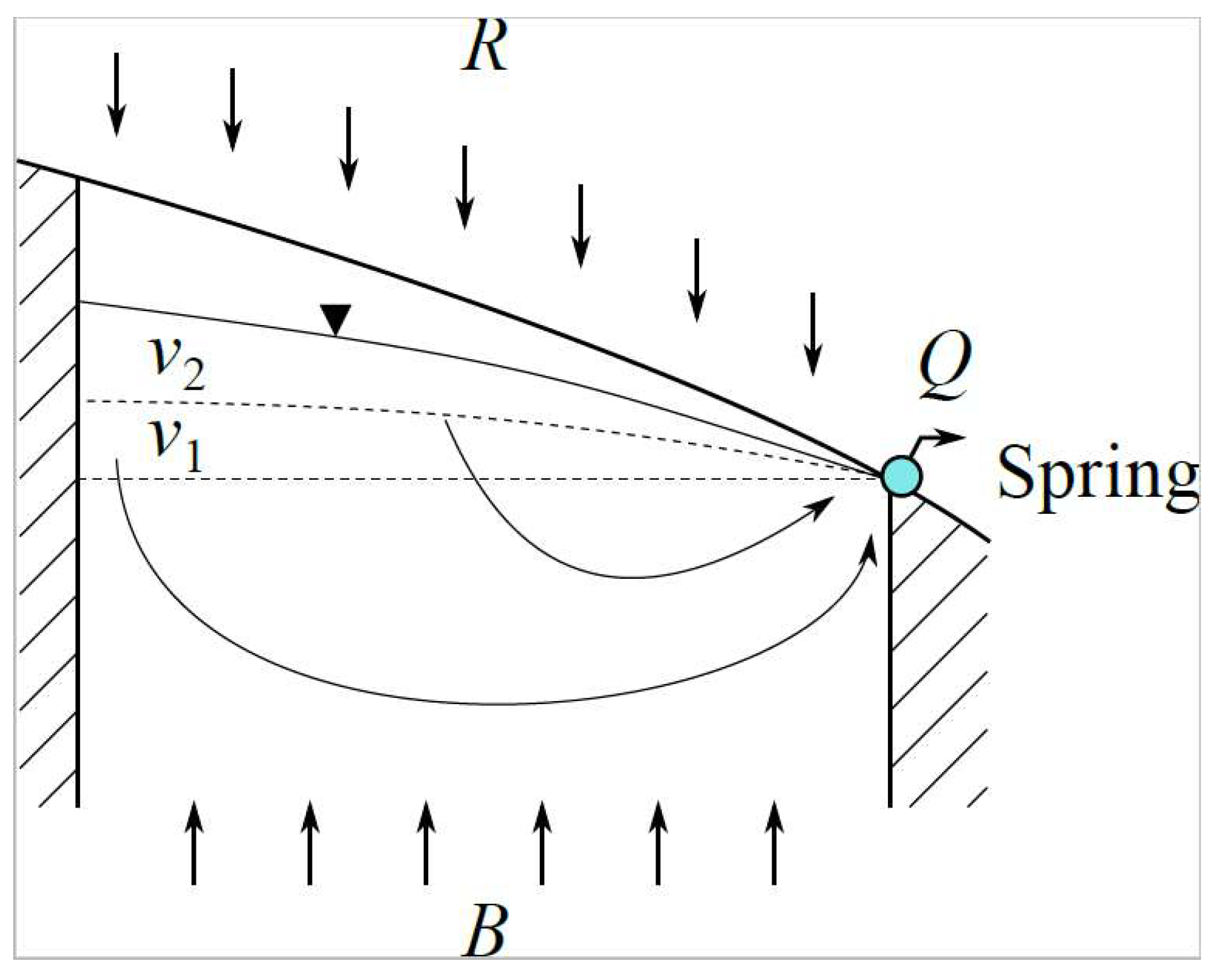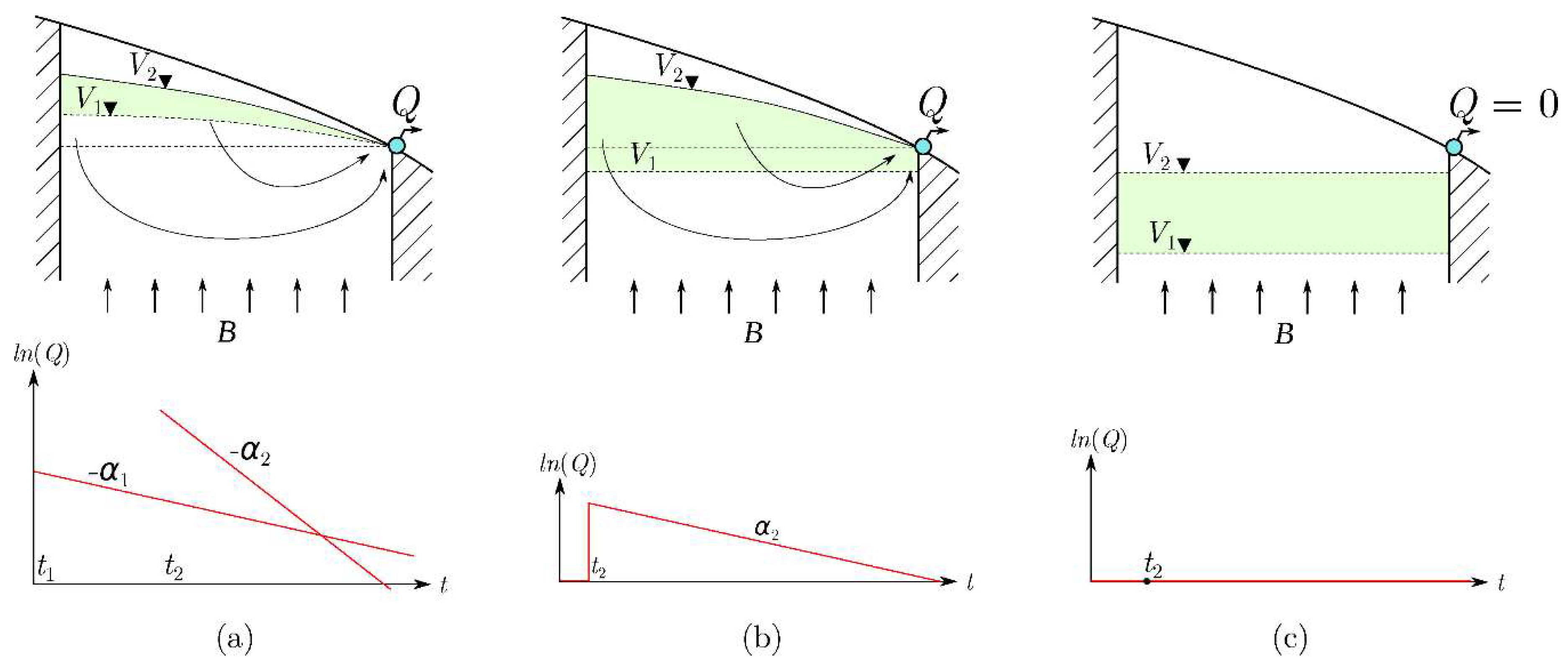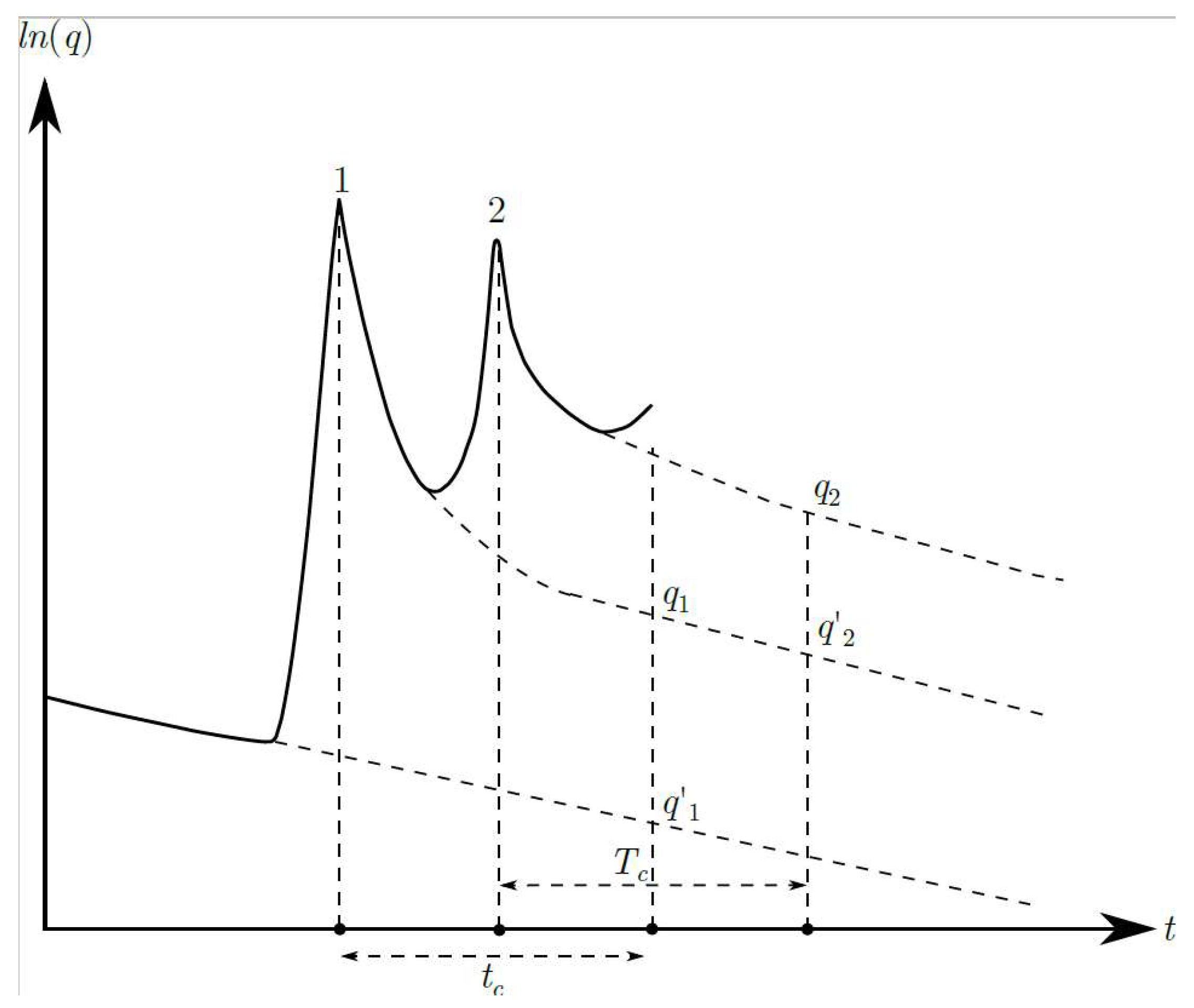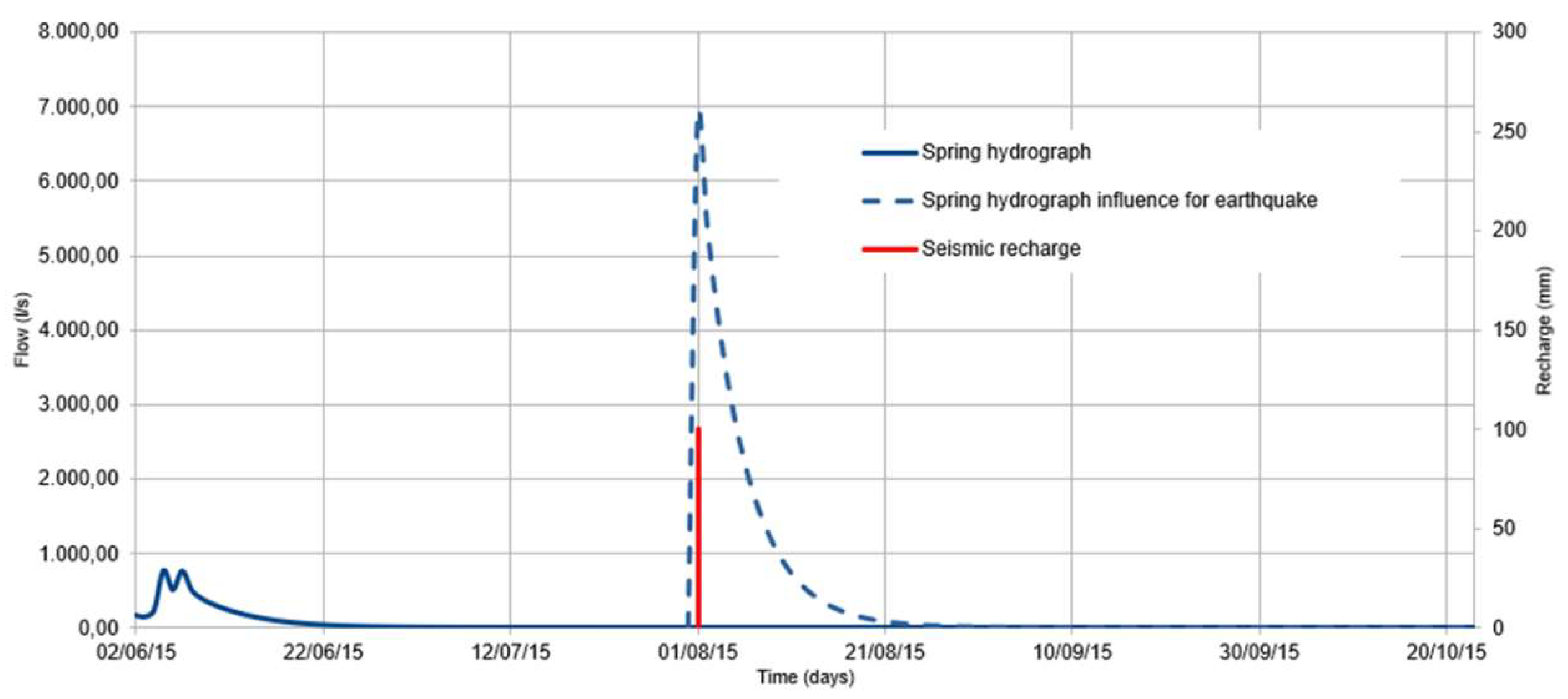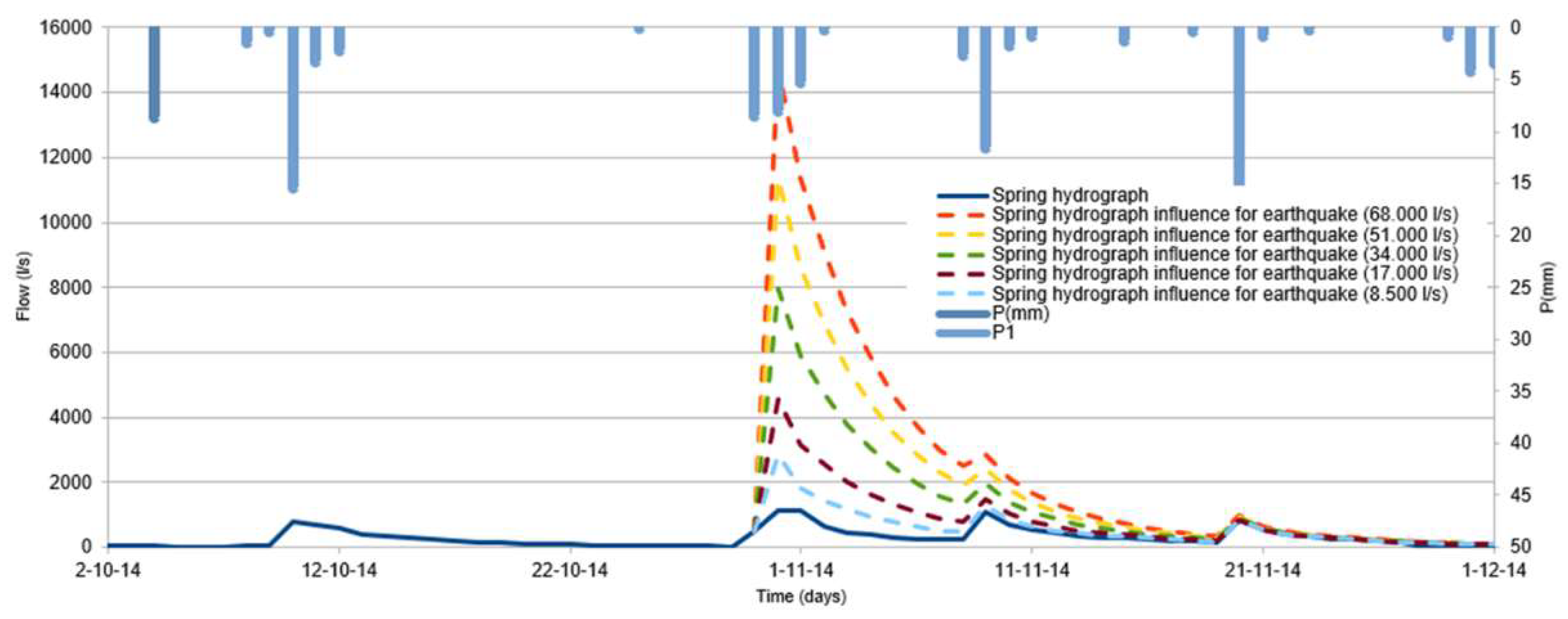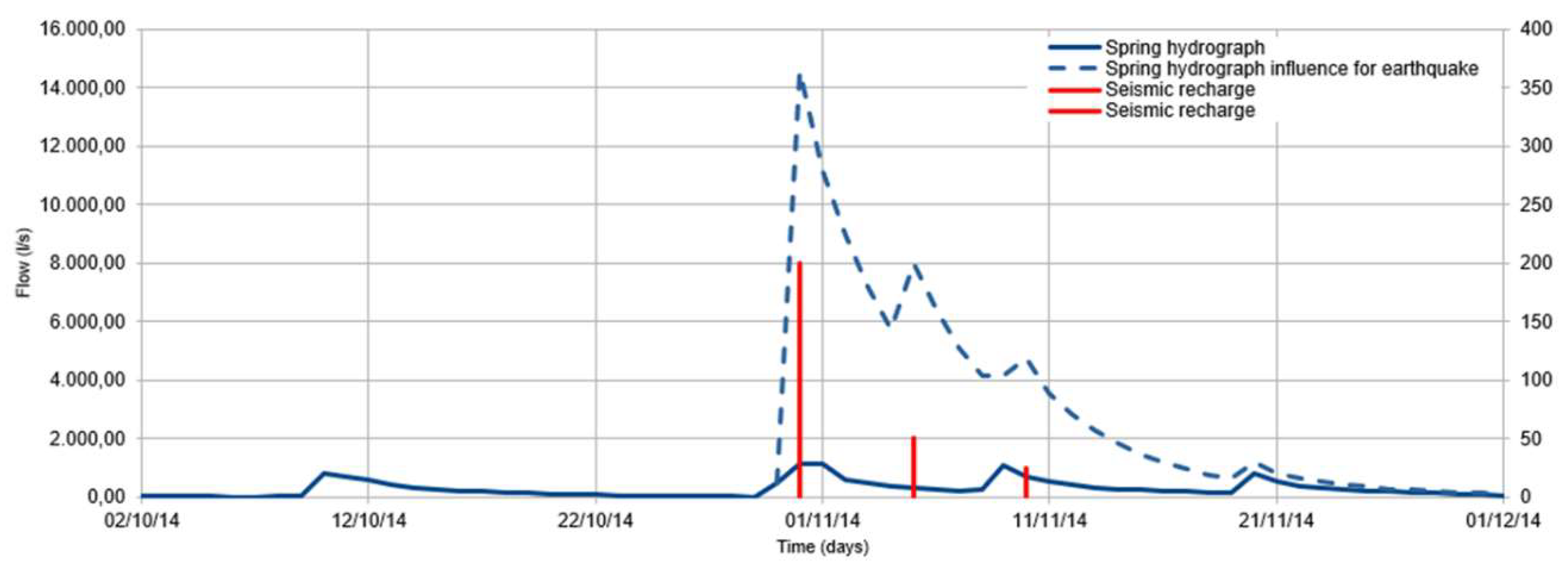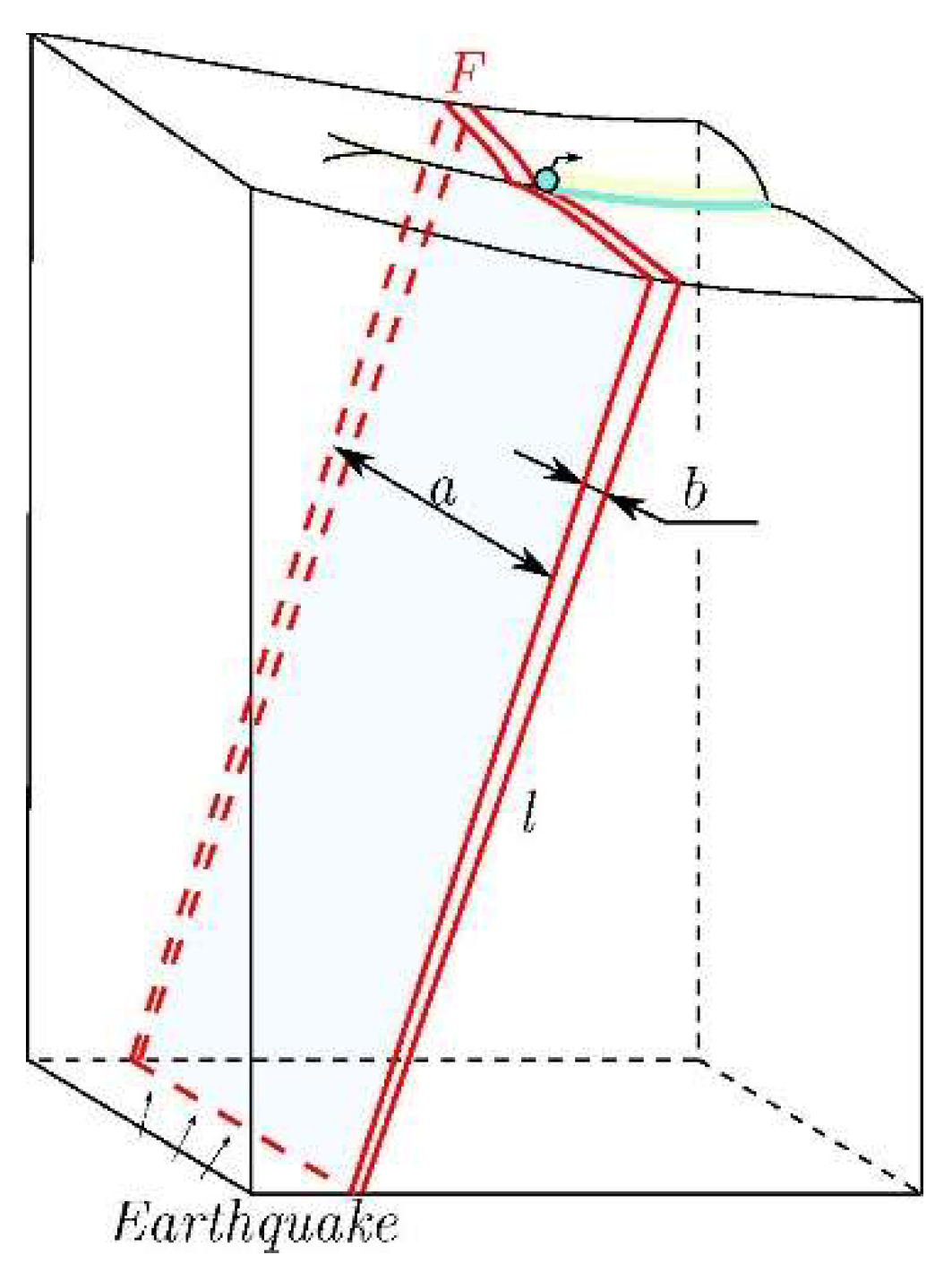1. Introduction
As is known, one of the most common hydrogeological effects induced by earthquakes is the persistent increase in spring and stream discharge connected to aquifers, as well as the rise in piezometric levels. These post-seismic flow increases can impact extensive areas and last for days, months, or even years. While extensively documented, the origins of these increases remain a subject of debate.
These observed phenomena result from the interaction between hydrogeological processes and the mechanical and tectonic properties of the Earth's crust in response to seismic deformation. Hence, they provide insight into the interaction among water cycle, tectonics, and crust properties. An earthquake induces changes in static and dynamic stresses in the crust, which decrease differently with distance.
The ultimate origin of these phenomena involves various mechanisms related to static and dynamic stresses [
1,
2], increased permeability [
2,
3,
4], and sediment consolidation [
4,
5,
6]. However, common hydraulic explanations draw on the ease or sensitivity of an aquifer to the increase in piezometric or hydraulic head potential due to the earthquake, manifesting in the rise of groundwater levels (groundwater level changes). This rise may result in the emergence of new springs or an increase in the flow of existing springs and water streams. This hydraulic explanation is directly related to diverse hydrogeological parameters of the aquifer, including diffusivity (hydraulic diffusivity) and the aquifer-specific storage coefficient, among others.
Thus, Sanz de Ojeda et al. (2019) [
7], reviewed the hydrogeological parameters that significantly influence the hydrological impact of earthquakes and developed a theoretical analytical model. This way, they proposed the depletion coefficient as the primary sensitivity parameter for persistent water level changes and alterations in springs in general.
This conceptual research provides insights into the application of groundwater hydraulics to increased spring discharges induced by earthquakes. Hydraulic calculations involve the depletion coefficient and hydrodynamic volumes of aquifers, revealing aspects of the interplay between groundwater and seismic activity.
Specifically, the pursued objectives are as follows:
1. Proposing various methods for estimating volumes and excess groundwater mobilized by earthquakes in springs. Analytical procedures or mathematical simulation methods used in groundwater hydraulics for calculating natural aquifer recharge are applied.
2. Explaining some of the potential mechanisms of increase and decrease in aquifer discharges induced by earthquakes based on the results of applying spring hydraulics: Clarifying the mechanisms of increased permeability during earthquakes, drawing attention to the large volumes moving internally, which could be a significant source of the origin of mineral deposits, for instance.
3. Recognizing faults as the primary geological structures in transmitting pore pressures due to earthquakes.
2. Materials and Methods
To estimate the excess spring discharge caused by earthquakes, we present procedures based on the analysis of depletion curves in spring hydrographs. We also adapt mathematical rainfall-runoff models used in simulating karstic spring hydrographs, along with analytical approximations derived from these models. We emphasize the potential and validity of these methods for studying this subject, such as predicting how a spring behaves during a seismic event, for instance.
2.1. Terminology and Background
2.1.1. The Depletion Coefficient of a Spring
Natural groundwater discharges on continents may occur through springs, which are localized outflows with appreciable flow rates, often associated with contacts between lithologies of varying permeability. Alternatively, discharges can occur diffusely along water streams hydraulically connected to the aquifer's water table.
The discharge rate of a spring from an aquifer with constant-level outflow under conditions unaffected by pumping or recharge, for example, is defined by the depletion curve, which can be calculated using an exponential-type equation:
where
is the discharge at time
,
is the initial discharge at the beginning of the recession or depletion curve (
), and the depletion coefficient is denoted by
(established by Boussinesq in 1877) [
8]. The expression for the depletion coefficient,
, is given by [
9]:
This equation implies that the depletion coefficient not only depends on the hydrogeological parameters of the aquifer, (hydraulic conductivity), and (storage coefficient), but also on the aquifer geometric properties: is the length from the center of gravity of the aquifer to the discharge point, and is the average saturated thickness of the aquifer. The aquifer transmissivity is given by .
To obtain the volume of groundwater stored in an aquifer above the spring (hydrodynamic volume or reserves) at the beginning of the recession period
, it is sufficient to integrate expression (1) from 0 to infinity:
From equation (3), it can be seen that α has the dimension of t⁻¹. Its value can be determined from equation (1) through the depletion phase hydrograph as follows:
If a sufficiently filled aquifer is conceptualized as multiple flow layers with different depletion coefficients
, the expression for
would be
Water circulation within the saturated zone can be highly complex, involving interactions with other potential porous or fractured aquifers, the coexistence of interconnected or non-interconnected fissures and conduits with different hydrodynamic properties, etc. These conditions depend on the position of the piezometric surface. It is generally accepted that when the latter is shallow at the beginning of discharge in an unconfined flow regime (after an earthquake, for example), drainage of all conduits and fissures, both large and small, occur. Undoubtedly, wider fissures drain more rapidly (higher slope ). However, after a certain point, their flow becomes negligible compared with that of smaller cracks, which often represent a larger volume of water but with a slower rate (lower slope ).
2.1.2. Theory of Seismic-Origin Discharge during Spring Recession
An earthquake originating from a nearby or distant source can cause a sudden increase or decrease in hydraulic head in an aquifer. From a hydraulic perspective, these are considered external actions on the aquifer. Unlike natural meteoric-origin recharge, other factors like precipitation and air temperature do not influence this recharge. Instead, it is triggered by a single, very rapid tectonic event. Also, clearly establishing the lower recharge area of the aquifer is uncertain, as it depends primarily on vertical hydraulic conductivity and, in any case, on the greater or lesser hydraulic connection with source zones where positive or negative pore pressures occur, even if these are shallow..
In the case of a pore pressure increase, regardless of the potential mechanisms that may cause it, there is a groundwater bottom-up flow (
), rapidly raising the piezometric level and increasing the hydrodynamic volume to
(
Figure 1). Here,
is the sum of the hydrodynamic volumes before the earthquake (
) and those caused by the seismic event (
), so that
(
Figure 1). After the earthquake, and until the previous equilibrium is restored through the depressurization of the system, this increase in stored volume can be drained in two ways: an outward flow through new or existing springs; and a downward flow (
). The latter becomes evident, for example, through the water level decrease measured by piezometers in aquifers without outlets. This can occur due to depressurization effects, as part of the general tendency to restore tectonic equilibrium. After restoring equilibrium, a residual volume might remain undrained, evident through a positive change in the water level.
Both piezometric levels and discharge increases are two ways of measuring the same phenomenon, which is a rapid pressure pulse initially and slow depressurization afterward. This becomes evident since the recession curve is similar for either well levels or spring discharges. This indicates that the depressurization mechanism is the same.
Depending on the initial situation and the increase in piezometric level due to the earthquake, the geological setting of the aquifer, and the site's topography, we can consider three common cases (
Figure 2):
If the piezometric level was already at the surface, then the earthquake will result in an increase in the discharge of existing springs and streams. The excess water due to the earthquake emerges to the surface and can be measured using flow gauging stations.
If the piezometric level did not reach the surface, but its increase due to the earthquake gives rise to new springs and streams. Only a portion of the excess water due to the earthquake can be measured at a flow gauging station; the rest can be observed through the water level decrease.
If the increase in the piezometric level due to the earthquake does not reach the surface, the excess water can only be observed through changes in the water level but cannot be quantified in terms of discharge.
The analysis in this work primarily builds on the first and second cases.
As for the earthquake, it provides a decreasing water input over time until it disappears (
Figure 2). As mentioned earlier, the aquifer can naturally operate with a discharge reflected in hydrographs that respond to mathematical functions of a single exponential (1) or a sum of several exponentials (5). Generally, it is a single exponential, but there could be a scenario where, during the period of increased flow due to the earthquake, the spring is discharging with two or more exponentials. However, we will disregard it in our analysis since it is a rare situation.
3. Results and Discussion
3.1. Spring Depletion Coefficient Due to the Earthquake
From the considered cases in
Figure 2, case 2a involves two depletion coefficients. This is reflected in the final resulting discharge curve: the one representing the aquifer's discharge as if there had been no seismic effect, and the exponential curve due to the earthquake (α₁ is the recession coefficient of the discharge curve before the seismic event, and α₂ is the depletion coefficient due to the earthquake). These two depletion coefficients have been observed in actual cases in both wells levels and spring discharge hydrographs, e.g., for the 1989 Loma Prieta earthquake [
1]; for the 1999 Chi-Chi earthquake [
9,
10,
11]; or for the Mw8.8 2010 Maule earthquake in Chile [
12].
A sketch of this hydrograph, neglecting aquifer inertias, is the composite recession curve shown in
Figure 3. In this case, in a semi logarithmic diagram, the hydrograph would consist of two straight lines, and the expression for the depletion curve would be:
In this expression, stands for the initial discharge at the beginning of the spring or stream depletion curve before the earthquake, is the pre-earthquake depletion coefficient of the spring discharge curve, is the increase in discharge mobilized by the earthquake, and is the coefficient of its depletion curve. However, it might also occur that only an increase in discharge could be observed, but with the same depletion curve characteristic of the spring before the earthquake ().
Some springs have revealed that after the earthquake-induced discharge increase, the aquifer depletes with its initial α value before the seismic events, behaving hydraulically as usual. This fact has been documented for the 1989 Mw6.9 Loma Prieta earthquake [
13] and the 1999 Chi-Chi earthquake [
10,
14]. Hence, Wang and Manga (2010 and 2021) [
5,
6] deduced that the mechanism of increased permeability could not explain the increased spring discharge due to earthquakes, as the depletion coefficient after a spring before and after an earthquake does not vary.
Figure 3.
Hydrograph in natural and semi logarithmic scale of a spring in an unconfined flow regime (recession) that undergoes, at time , the instantaneous effect (without inertia or delays) of deep pumping due to the action of an earthquake. The post-earthquake slope of the spring's depletion curve is assumed larger than before the earthquake (). For the depletion curve follows the equation . From onward, the discharge curve is expressed as . is the spring discharge at the beginning of the recession , is the discharge induced by the earthquake at time , and is the spring discharge at the moment of the earthquake: .
Figure 3.
Hydrograph in natural and semi logarithmic scale of a spring in an unconfined flow regime (recession) that undergoes, at time , the instantaneous effect (without inertia or delays) of deep pumping due to the action of an earthquake. The post-earthquake slope of the spring's depletion curve is assumed larger than before the earthquake (). For the depletion curve follows the equation . From onward, the discharge curve is expressed as . is the spring discharge at the beginning of the recession , is the discharge induced by the earthquake at time , and is the spring discharge at the moment of the earthquake: .
However, this does not seem to be the case, as a sensitivity analysis of the different variables involved in this coefficient, according to equation (2), demonstrates that significant increases in permeability translate into imperceptible variations in the depletion coefficient. For example, in the Vozmediano Spring, with an average discharge of 1,100 l/s (Spain), if the permeability of the entire aquifer varies from
=1.1 m/day to
=1.2 m/day, the depletion coefficient would change from
to
[
15]. We would need to increase an order of magnitude (
=2 m/day) for the coefficient to vary relatively significantly (
). We can then verify that significant changes in aquifer permeability are masked within the margins of measurement errors of spring discharge gauging. The changes in slope on the recession lines are so small that they are imperceptible at the hydrograph drawing level.
However, this does not imply that there cannot be a very significant increase in permeability occurring at great depths, near the rupture zone. But its influence on the average permeability of the entire aquifer will be small if the aquifer draining the spring is large (parameter in equation (2)). However, if we restrict ourselves to faults, we do believe that vertical permeability can be substantially improved over geological timescales.
3.2. Calculation of Postseismic Excess Discharge and the Mobilized Volume of Water Due to Earthquakes
Not all water mobilized by an earthquake can be quantified as postseismic excess discharge, as it does not always surface. This occurs when piezometric levels only rise but later return to lower levels and reach equilibrium. Therefore, the estimation of excess discharge measured in springs and streams will be a minimum of the water mobilized by earthquakes.
In the case of new springs and streams (
Figure 2c), after the initial abrupt increase, there will be a descending branch in the hydrograph with slope
, as in the previous case, until the new spring dries up at
, after which only the piezometric level descent due to depressurization or downward flow will operate.
In the case 2-D, only levels are available, and the effect operating in the piezometric level descent is the downward flow, with the manifestation of a single descending branch with slope . If tools were available to convert elevations into discharge (mathematical models, for example), discharge hydrographs could be obtained, and excess volumes due to earthquakes could be calculated.
3.2.1. Estimation of the Volume Mobilized by an Earthquake Using the Hydrograph of a Spring
The volume of water discharged by the earthquake (
) is the increase in hydrodynamic volume of the aquifer, which, from the hydrograph, can be calculated as the difference between the volume discharged by the spring after the earthquake and what it would have discharged if the earthquake had not occurred:
where
is the spring discharge at the beginning of the recession, and
is the flow induced by the earthquake. A simple way to estimate this volume is
Expression (7) can easily related to the colored region of
Figure 3, i.e.,
. The previous graph corresponds only to the case in which the spring was flowing at the time of the earthquake occurrence. The possibilities with their respective graphs (
Figure 2) are as follows.
3.2.2. Analysis of Spring Hydrographs
Regardless of other methods for calculating recharge using piezometric variations or mathematical models, we will focus here on those that utilize the spring hydrograph. We will consider recharge as the excess discharge draining through a spring due to an earthquake. These methods are based on the analysis of hydrograph peaks: the surges that occur as a result of upward flow due to an earthquake and their subsequent decline when the seismic activity has ceased. In addition to the method proposed by Wang and Manga (2010, 2021) [
5,
6], we present below, as an example, the recession curve shifting method. Other similar methods can be found in Sanz Pérez (1997) [
16,
17,
18]. The goal is not to exhaust the topic but to adapt and apply hydrogeological theory to earthquake scenarios to demonstrate the possibilities of these estimations.
3.2.3. The Recession Curve Shifting Method
This method is based on raising the recession curve of the discharge ensuing from recharge induced by an earthquake from below. It includes the possibility of analyzing the inflow injections from various events, such as aftershocks, although the first event causes the most significant surge in the spring. If α is the depletion coefficient, which has been determined beforehand, it assumes that at the so-called "critical time" () from the end of the recharge, the spring acquires its base flow.
For each hydrograph peak, with semi logarithmic representation (
Figure 1), estimate on the graph the descent curve of the peak until it becomes parallel to the recession line or, in other words, with slope α, at the "critical time." At this moment, measure the flows
from the recession line of the peak and
from the previous recession.
Formulations by Glover (1964) [
19] and Rorabaught (1964) [
20], automated later by Rutledge and Daniel (1994) [
21], show that the total potential groundwater recharge at a critical time after the flow peak is approximately equal to half the recharged water volume into the system. Therefore, for peaks 1 and 2 in
Figure 4, the following recharges
and
would be obtained:
3.2.4. Rainfall-Runoff Mathematical Models
For the mathematical description of recharge and discharge transfer in the simulation of spring hydrographs and well levels, mainly aggregated models and uni- and multicellular models have been employed, some of which are also called black-box models. A variety of authors explained some of such models, e.g. [
15,
22,
23,
24]. These approaches consider simplified models of aquifers, i.e., they are constituted by one or several fictitious cells, assimilable to natural deposits, presenting different celerity in the drainage of their hydrodynamic volume or renewable reserves, depending on their depletion coefficient.
In the encompassed multicellular models, for example, modeling is expressed exclusively under drained flow conditions, volumes, and recharges in each decomposition cell. Therefore, knowledge of piezometric level series is not required, as they do not intervene in the calculation. The quantification of evapotranspiration is not required, nor is the aquifer geometry and conditions at the borders; only the total surface of the aquifer and the precipitation and natural flow gauge series of the spring are necessary.
Nevertheless, some other valuable models such as SIMERO [
15], or CREC [
22,
24] are more appropriate for the case at hand. These models consider the aquifer as divided into three deposits distributed in series and representing three successive water stages, from precipitation to its outlet to the spring. In the first, a conventional hydraulic balance is operated, from which the water comes out to the unsaturated zone (second deposit) and saturated (third deposit), where the flow undergoes a delay and phase shift. SIMERO can assume a linear and invariant system, by specifying such condition in the last two layers, and therefore, the circulation of water is expressed by a convolution integral. In the CREC model, the deposit representing the unsaturated zone is responsible for the nonlinear drainage of the aquifer and the transfer of flow to the saturated zone, and in the latter, linear drainage occurs. From these models, flows, pressures, and volumes can be obtained.
Application to the case of seismic alteration of a spring These precipitation-runoff models could simulate not only flow variations but also pressure variations, i.e., piezometric level variations. For this, a reasonable assumption is made, such as that recharge comes from bottom to top, passing directly to the saturated zone. In this way, the flow does not undergo the reduction of a balance in the soil, such as rain-infiltrated water, nor the delay and phase shift of the following deposits of mathematical models. It is as if we recharged the aquifer by injecting water through a well into the saturated zone.
As an example, we present the simulation of an earthquake affecting the Fuentetoba Spring (Soria, Spain) [
24,
25,
26]. Such a spring drains a karstic aquifer naturally, without exploitation wells, and the recharge comes only from rainfall. It has an average flow of 200 l/s, but a very variable regime, so that it has peaks of up to 7,000 l/s, although it can also dry up. Its hydrograph was simulated using the CREC model for 20 years, so it is very well calibrated. The first simulation of an earthquake involved injecting a recharge directly into the saturated zone during a time without rainfall and a dry spring, albeit with the water table at the natural drain outlet level of the spring. It could be assimilated somehow to the appearance of new springs due to the effect of an earthquake. The recharged flow was practically instantaneous (31 July 2011), and with a very large amount (100 mm spread throughout the aquifer). As shown in
Figure 5, the reaction was immediate, with a vertical ascending branch in the hydrograph, and a spring-depletion-coefficient dependent recession that lasted more than a month, until it dried up again.
In the case of a spring that is active during seismic-induced recharge,
Figure 6 presents the results of various simulations for the same Fuentetoba Spring. Different recharge values are considered for hypothetical earthquakes without aftershocks occurring on October 30, 2010. As expected, we observe the immediate effect of seismic recharge in all cases, and later, the aquifer emptying law is reflected according to its α, which prevails for seismic recharges with higher values. The separation in the hydrograph of the two effects, rainfall recharge, and seismic recharge, is very clear. We highlight that the use of these models enables this differentiation even during intense rainfall events that could obscure a co-seismic increase. We also observe how the seismic effect persists for more than 15 days in all cases. The persistence time increases with seismic recharge, but it does not influence as much. It is assumed that aftershocks contribute to the persistence time.
The last simulation assumed a 200 mm recharge, corresponding to the main earthquake, along with aftershocks 5 and 10 days later with 50 mm and 25 mm, respectively.
Figure 7 depicts how the persistence time remains significantly longer, and the slopes vary based on the juxtaposition of events.
3.2.5. Effects of Seismic-Induced Recharge Actions Using Analytical Solutions Derived from Precipitation-Runoff Mathematical Models.
After a spring has been previously simulated by using a rainfall-runoff model, including its iterative formulas and once discretized, there are analytical solutions to calculate the effects on its flow from deep seismic-origin recharges. Pressure buildups (piezometric levels) can also be calculated. In these cases, the aquifer is considered homogeneous, and it is assumed that deep seismic-origin recharges are instantaneous and uniformly distributed along the aquifer or around its center of gravity. These induced actions consist of seismic-origin recharges, as mentioned (similar to artificial recharges in conventional hydrogeology), or effects of seismic pumping on the aquifer that lead to the decrease or drying up of springs (similar to groundwater pumping through wells in conventional hydrogeology). The mathematical treatment is analogous in both cases, but the sign of these recharges is changed.
For one of the most well-known mathematical models (MERO), these solutions are given in Sanz Pérez (1997 and 1999) [
16,
17,
18,
27] and adapted to the case of fluid flow or pressure from an earthquake, summarized in the following iterative formula, where
is the actual contribution of the spring, considering the effect of seismic recharges up to period
.
where
is the flow that the spring would have if there were no seismic-origin recharges in period
or the preceding ones, and
is the difference between the two aforementioned values—the increase in the historical flow of the spring due to all seismic-origin recharges made up until period
.
These formulas can be applied to the extreme case of a significant spring decrease and drying up due to earthquakes. It is a case opposite to those seen in this study but will serve to verify the possible mechanism that originates it. As an illustrative example, Vozmediano is a spring with an average flow of about 1,100 l/s. This spring is located in the Iberian Mountain Range (Spain) and drains a large limestone aquifer over 1500 m thick with significant confinement. Its hydrodynamic volume at the average initial date of the depletion curves has been estimated 25 hm
3, with a flow rate of 870 l/s. Its hydrograph was simulated for 20 years by using the SIMERO model [
15,
16,
17,
18], and presents an analysis of the effects on its flow from a possible artificial recharge made at the center of gravity of its aquifer.
According to Sanz et al. (2020) [
25,
26], this spring exhibits the same behavior during earthquakes: a sudden post-seismic decrease (never an increase) lasting several hours (no more than 24 hours) and a rapid, progressive increase until the previous flow is restored. During recovery, the water comes out with white turbidity for no more than 24 hours. This behavior repeats itself for strong or moderate earthquakes in both the far field —like the Lisbon earthquake of 1755, M (8-9)— and the near field (like the one on 3/09/1961 in Aguilar del Rio Alhama, La Rioja, M5). The flow modification depends on the felt intensity at the site, regardless of its magnitude and distance. In the nearby earthquake of Aguilar del Rio Alhama on 3/9/1961 (M5), the Vozmediano Spring, which had a flow rate of 780 l/s, gradually dried up within 20 minutes an hour after the earthquake and two minutes after an aftershock. It remained completely dry for nine hours, leading to a lack of electrical production in the power plants until, also gradually, it recovered its previous flow. During the Lisbon earthquake of 1755, this spring dried up completely for approximately one day [
25,
26].
The consequences of these seismic events on the discharge of the Vozmediano Spring can be evaluated using equations (7). This analysis helps confirm that achieving its desiccation would necessitate pumping a volume of water approximately equivalent to its hydrodynamic capacity within a single day, which is practically unattainable. To elucidate the potential desiccation mechanism of this spring, there is no need to invoke significant alterations in the hydraulic parameters of the aquifer. In this scenario, it appears evident that stress variations induced by earthquakes can lead to changes in elastic parameters and temporary deformations in the rock. Consequently, the storage coefficient, contingent upon the vertical compressibility coefficient of the aquifer and its substantial thickness in this instance, can undergo a temporary increment, enabling the retention of water that would otherwise discharge through the spring over a day.
3.3. Confirmation of Faults as Principal Pathways for Fluid Pressure Transmission Due to Earthquakes
While the fact that faults serve as preferential conduits for transmitting fluid pressure during seismic events is established, employing the depletion coefficient as a hydraulic parameter offers a quantifiable confirmation of this assertion. As demonstrated by Sanz de Ojeda et al. (2019) [
7], the significance of faults as sensitive geological discontinuities for transmitting fluid pressure surpasses other lithologies during seismic events, particularly evident in the Lisbon earthquake of 1755.
Anticipating such behavior from faults seems reasonable, given their typical attributes as confined aquifers characterized by a very small storage coefficient (
) and a substantial length (
). Let's consider a fault F discharging through a spring (
Figure 8). This fault exhibits a small saturated thickness
(a few meters), a length
(hundreds of meters), and a subvertical (non-vertical) dip, ensuring that the aquifer in the fault zone becomes confined at shallow depths. Assigning standard values to the variables in equation (2), defining the depletion coefficient, such as
for fractured zones (Hoek and Bray, 1981),
for confined aquifers like this one, and
10 m for major faults. Consequently:
If m ⇒ α = 2131.83 days-1.
If m ⇒ α = 85.27 days-1.
If m ⇒ α = 21.31 days-1.
It is evident that all α values are greater than 0.1 days-1, and as the fault length decreases, α (its hydraulic sensitivity to earthquakes) increases. While other factors (, , ) could be varied, these calculations suffice to verify that faults generally exhibit elevated α values. In conclusion, depletion coefficient (α) values corresponding to faults of considerable length, such as those connecting the Earth's surface to the depths of the crust where earthquakes originate, tend to be high (α>0.1 days-1). This heightened sensitivity to pore pressure renders faults more responsive than other lithologies.
3.4. The Bottom-Up Piston Flow Model and the Darcian Laminar Regime Seem to Explain Why the Water Increment in Springs after an Earthquake Does Not Significantly Raise Its Temperature or Alter Its Chemical Composition.
It has been observed that variations in the chemical composition and temperature of many springs that increase their flow due to earthquakes are not as substantial as might be expected initially (e.g., Rojstaczer and Wolf, 1992, in the 1989 Loma Prieta earthquake [
28]). However, as depicted in
Figure 1 and
Figure 2 and the equations derived here from a laminar Darcian regime, everything indicates a piston-type flow, where the fault rupture acts as a fluid pressure pump pushing groundwater upwards, with minimal mixing with the lower part. Despite this, the uplift eventually results in an increase in piezometric levels or surface spring flows. In other words, the water emerging originates from the upper part, which is similar in composition and temperature to that exiting the spring.
As the regime is laminar, the actual velocity is , where is hydraulic conductivity, is the hydraulic gradient (the modification of is crucial in the case of an earthquake), and is the effective porosity. For an earthquake at a depth of 5 km, for instance, a velocity of 5 km/day (5.78 cm/s) would be required for water to reach the surface in accordance with the observed rapid increase in hydrographs. However, even assuming this velocity, and with values for the dynamic viscosity of water at 100°C and a fault width of 2 mm, for example, the Reynolds number would exceed the laminar regime. For greater depths, necessary velocities would demand turbulent regimes.
3.5. Groundwaters Mobilized by Earthquakes and the Origin of Hydrothermal Mineral Deposits
As known, structural evidence indicating that the mineralization of hydrothermal deposits was synchronous with ancient host faults led many researchers to propose the connection between episodes of hydrothermal precipitation and increased seismic ruptures when those faults were active. The presence of fluids at high temperatures and high mineralization in the upper half of the seismogenic continental crust, the generation of permeability associated with rupture, and mineral precipitation due to sudden pressure reductions or fluid mixing at specific structural sites all indicate the significant role played by seismic pumping flow. This not only explains many deep hydrothermal deposits but also shallower deposits like those of the Mississippi Valley type, whose source of mineralized thermal water is attributed to seismic origins associated with specific faults. The works of Sibson et al. (1975) and Sibson (1990) are crucial in this regard [
29,
30]. However, this is not yet well-quantified. The application of groundwater hydraulics and mathematical models can shed light on the subject. For instance, estimating the hydrodynamic volumes mobilized by an earthquake over geological history is fundamental to understanding the mineralizing potential and capacity that seismic pumping can produce. This section only aims to initiate the topic.
Direct evidence of fluid involvement with earthquakes comes from post-seismic discharges near active faults. In the Chi-Chi earthquake alone, over 2 km³ of groundwater expelled through some streams was estimated [
10,
14]. One must consider that the water mobilized by an earthquake can surpass that expelled by springs and watercourses hydraulically connected to aquifers, as not all water can be drained by gravity to the exterior. As seen in section 3.2.1, the water mobilized above the drainage level, which can be consistently drained through a spring activated by an earthquake, can be calculated in its hydrograph by the difference in hydrodynamic volumes before and after the earthquake. For instance, for a spring with a flow rate of 100 l/s and a constant depletion coefficient of α=0.0033 days⁻¹ that increases to 500 l/s due to an earthquake, the volume of water mobilized and drainable by gravity, calculated by the formula
, would increase from 2.6 hm³ to 13.09 hm³, which is 5 times more. The time "
" it would take for this spring to return to 100 l/s without recharge would be determined by the equation:
where
500 l/s (0.5 m³/s) and
100 l/s (0.1 m³/s), resulting in
days. The volume evacuated during this period would be 8.4 hm³.
The recurrence intervals between successive main earthquakes typically range from one decade to many thousands of years, depending on the fault's activity level. Consider, for instance, an active fault with a return period of 500 years mobilizing 1 km³ in each event; this would be equivalent to a continuous flow of approximately 63 l/s over those 500 years. Moreover, a significant portion of the mobilized water expelled externally is likely to be from the upper part. Therefore, the hot and mineralized water is not renewed but rather stirred near the fault. This water fractures the rock, increases its porosity, mineralizes, and, in turn, refills it.
4. Conclusions
Given that earthquakes and water interact through changes in both stress and the physical properties of rocks, understanding the origin of hydrological responses can provide valuable insights into hydrogeological and tectonic processes at spatial and temporal scales that would otherwise be challenging to study. Additionally, there is still much to learn about the interactions between water and earthquakes, with numerous unresolved issues.
Through the application of spring hydraulics to the increased flow of streams and springs induced by earthquakes, this article provides various techniques for estimating the volumes released externally and calculating seismic-origin recharge. For the calculation of this recharge, hydrograph analysis, mathematical rainfall-runoff models, and analytical functions derived from these are employed. Mathematical models are particularly interesting as, once a spring is simulated under natural conditions before an earthquake, we can analyze and distinguish the earthquake's effect on flow hydrographs or pressures (water levels in piezometers), or predict a spring's behavior during seismic action. The rainfall during the post-seismic increase is considered in the simulated hydrograph and cannot obscure the induced earthquake flow response.
Careful attention is drawn to the large volumes moving internally, which could be a significant source of the origin of mineral deposits, for example.
On the other hand, the analysis of the depletion coefficient recognizes faults as major geological structures in transmitting pore pressures due to earthquakes. It appears that this coefficient cannot be used as a tool to identify permeability changes during earthquakes. Finally, it emphasizes the large volumes of water moving within the crust, which could be a significant source of the origin of mineral deposits, for example.
6. Patents
Not applicable.
Author Contributions
Conceptualization, E.S. and J.S.O.; methodology, E.S. and J.S.O; software, P.R.R.; validation, E.S., J.C.M. and P.R.R.; formal analysis, E.S. and P.S.O.; investigation, E.S., J.C.M. and P.R.R.; resources, E.S., P.S.O. and J.C.M.; data curation, E.S., P.S.O. and P.R.R.; writing—original draft preparation, E.S. and J.C.M.; writing—review and editing, E.S., J.C.M. and P.S.O.; visualization, E.S., J.C.M. and P.S.O.; supervision, E.S., J.C.M.; project administration, E.S.; funding acquisition, E.S. All authors have read and agreed to the published version of the manuscript.
Funding
This research received no external funding.
Data Availability Statement
The data presented in this study are available from the authors upon request.
Acknowledgments
In this section, you can acknowledge any support given which is not covered by the author contribution or funding sections. This may include administrative and technical support, or donations in kind (e.g., materials used for experiments).
Conflicts of Interest
The authors declare no conflict of interest.
References
- Muir Wood, R.; King, G.C.P. Hydrological signatures of earthquake strain. J. Geophys. Res. 1993, 98, 22035–22068. [Google Scholar] [CrossRef]
- Wakita, H. Water wells as possible indicators of tectonic strain. Science 1975, 189, 553–555. [Google Scholar] [CrossRef] [PubMed]
- Jónsson, S.; Segall, P.; Pedersen, R.; Björnsson, G. Post-earthquake ground movements correlated to pore-pressure transients. Nature 2003, 424, 179–183. [Google Scholar] [CrossRef] [PubMed]
- Montgomery, D.R.; Manga, M. Streamflow and water well responses to earthquakes. Science 2003, 300, 2047–2049. [Google Scholar] [CrossRef] [PubMed]
- Wang, C.Y.; Manga, M. Earthquakes and water. In Lecture notes in Earth sciences, (Vol. 114). Berlin, Heidelberg: Springer, 2010, ISBN: 978-3-642-00809-2. https://www.springer.com/series/772.
- Wang, C.Y., Manga, M. Water and Earthquakes. In Lecture notes in Earth System Sciences, (Open Access). Berlin, Heidelberg: Springer, 2021. ISBN 978-3-030-64307-2. S: notes in Earth System Sciences, (Open Access). Berlin, Heidelberg, 2021. [CrossRef]
- Sanz de Ojeda, A.; Alhama, I.; Sanz, E. Aquifer sensitivity to earthquakes: The 1755 Lisbon earthquake. J. Geophys. Res. : Solid Earth 2019, 124, 8844–8866. [Google Scholar] [CrossRef]
- Boussinesq, J. Essai sur la théorie des eaux courantes. Mémoires présentés par divers savants à l'Académie des Sciences France, 1877, 23(pt6), 252–260. Available online: https://gallica.bnf.fr/ark:/12148/bpt6k56673076.texteImage.
- Chia, Y.; Wang, Y.S., Wu, H.P. et al., Changes of ground water level in response to the Chi-Chi earthquake. International workshop on annual commemoration of Chi-Chi earthquake. National Center for Research on Earthquake Engineering, Taipei, 2000, pp 317–328 http://ntur.lib.ntu.edu.tw/handle/246246/134812. 2462.
- Wang, C.-Y. , Wang, C.-H., & Kuo, C.-H. Temporal change in groundwater level following the 1999 (Mw = 7.5) Chi-Chi earthquake, Taiwan. Geofluids, 2004, 4, 210–220. [Google Scholar] [CrossRef]
- Chia, Y. , Wang, Y. S., Chiu, J. J., & Liu, C. W. Changes of groundwater level due to the 1999 Chi-Chi earthquake in the Choshui River alluvial fan in Taiwan. Bull. Seismol. Soc. Am. 2001, 91, 1062–1068. [Google Scholar] [CrossRef]
- Mohr, C.H.; Manga, M.; Wang, C.Y.; Korup, O. Regional changes in streamflow after a megathrust earthquake. Earth Planet Sci Lett 2017, 458, 418–428. [Google Scholar] [CrossRef]
- Manga, M. Origin of postseismic streamflow changes inferred from base flow recession and magnitude-distance relation, Geophys. Res. Lett. 2001, 28, 2133–2136. [Google Scholar] [CrossRef]
- Wang, C.Y.; Wang, C.H; Manga, M. Coseismic release of water from mountains: evidence from the 1999 (Mw = 7.5) Chi-Chi, Taiwan, earthquake. Geology 2004, 32, 769–772. [Google Scholar] [CrossRef]
- Sanz Pérez, E. Application and simplification of the SIMERO model for the Vozmediano Spring (Spain). Hydrol. Sci. J. 1996, 42, 763–779. [Google Scholar] [CrossRef]
- Sanz Pérez, E. Estimation of Basin Wide Recharge Rates Using Spring Flow, Precipitation, and Temperature Data. Groundwater 1997, 35, 1058–1065. [Google Scholar] [CrossRef]
- Sanz Pérez, E. Management of an aquifer with artificial recharge using water balance. Hydrol. Sci. J. 1997, 42, 909–918. [Google Scholar] [CrossRef]
- Sanz Pérez, E. Simulación de la recarga artificial de un acuífero en su manantial. Aplicación al manantial de Vozmediano. Estud. Geológicos 1997, 53, 17–23. [Google Scholar] [CrossRef]
- Glover, R. E. Ground-water movement. U.S. Bureau of Reclamation Engineering Monograph Series 31, 1964. Pp.31-34.
- Rorabaugh, M.I. Estimating changes in bank storage and ground-water contribution to streamflow. International Assoc. Of Scientific Hydrology. Publication 63, 1964, pp. 432–441.
- Rutledge, A.T.; Daniel, C.C. , Testing and automated method to estimate ground-water recgarge from streamflow records. Ground Water 1994, 32, 180–189. [Google Scholar] [CrossRef]
- Guilbot, A. Modélisation des ecoulements d’un aquifer karstique (liasons pluie –débit).Aplication aux bassins de Saugras et du Lez. Thèse d’Université, USTL Montpellier, 1975.
- Estrela, T.; Sahuquillo, A. Modeling the Response of a Karstic Spring at Arteta Aquifer in Spain. Ground Water 1997, 35, 18–24. [Google Scholar] [CrossRef]
- Rosas, P.; Sanz, E.; Menéndez-Pidal, I. Hidrogeología del Karst de Pico Frentes (Cordillera Ibérica, España). Estud. Geológicos 2016, 72, 1–21. [Google Scholar] [CrossRef]
- Sanz, E.; Menéndez-Pidal, I.; Escavy, J.I.; Sanz de Ojeda, J. Hydrogeological Changes Along a Fault Zone Caused by Earthquakes in the Moncayo Massif (Iberian Chain, Spain). Sustainability 2020, 12, 9034. [Google Scholar] [CrossRef]
- Sanz, E.; Rosas, R.; Menéndez-Pidal, I.; Sanz de Ojeda, J. Management and Conservation Strategies for Fuentetoba Springs (Spain). Sustainability 2020, 12, 10131. [Google Scholar] [CrossRef]
- Sanz Pérez, E. Simulation of Spring Management with Quasi Aggregated Model. J. Hydrol. Eng. 1999, 4, 77–79. [Google Scholar] [CrossRef]
- Rojstaczer, S.; Wolf, S. Permeability changes associated with large earthquakes: an example from Loma Prieta, California, 10/17/89 earthquake. Geology 1992, 20, 211–214. [Google Scholar] [CrossRef]
- Sibson, R.H.; Moore, J.M.M.; Rankin, A.H. , Seismic pumping hydrothermal fluid transport mechanism. J. Geol. Soc. Lond. 1975, 131, 635–659. [Google Scholar] [CrossRef]
- Sibson, R.H. Faulting and fluid flow, in Nesbitt, B.E. (ed.), Short Course on fluids in tectonically active regime of the continental crust: Canada, Mineralogical Association of Canada, 1990, 93-132. https://cir.nii.ac.jp/crid/1130282269837047168. 1130.
|
Disclaimer/Publisher’s Note: The statements, opinions and data contained in all publications are solely those of the individual author(s) and contributor(s) and not of MDPI and/or the editor(s). MDPI and/or the editor(s) disclaim responsibility for any injury to people or property resulting from any ideas, methods, instructions or products referred to in the content. |
© 2023 by the authors. Licensee MDPI, Basel, Switzerland. This article is an open access article distributed under the terms and conditions of the Creative Commons Attribution (CC BY) license (http://creativecommons.org/licenses/by/4.0/).
